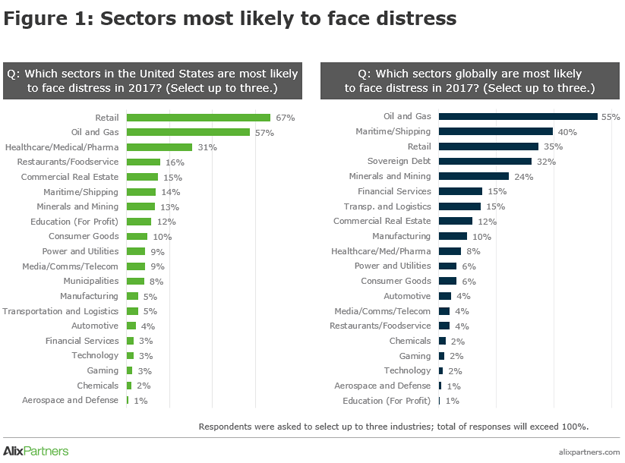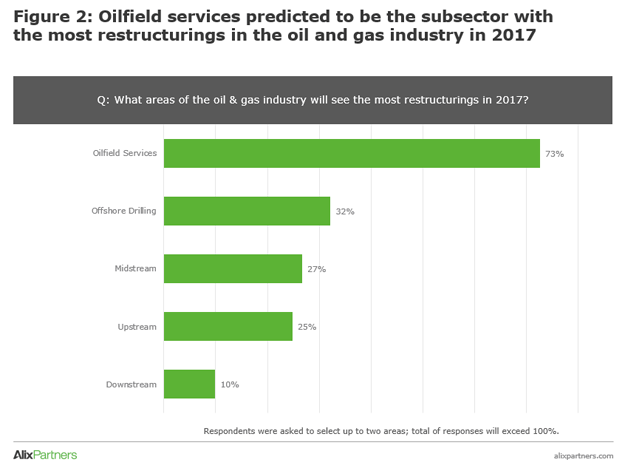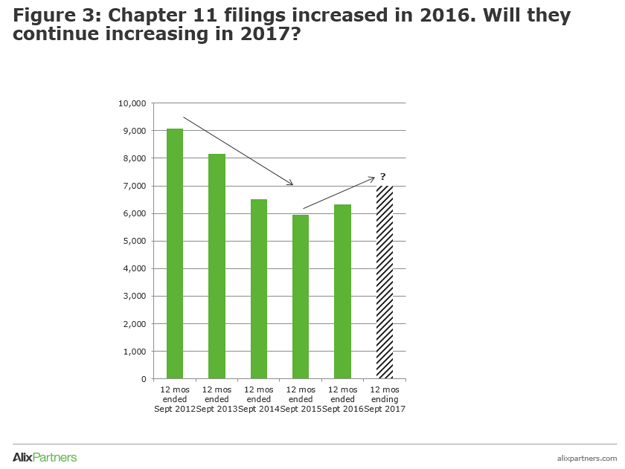
Change and uncertainty are spreading across the globe. The Brexit vote, election of Donald Trump as president of the United States, and swings in oil prices ranging from a low of $27 per barrel in January 2016 to a high of $57 at year end¹ underscore an expected increase in restructuring activity both in the United States and around the world, according to our 2017 North American Restructuring Experts Survey.²
Pro-growth tax policies and infrastructure spending that may be favored by the new U.S. administration may benefit some sectors. In addition, a rising stock market with peaks above a Dow milestone of 20,000 may provide companies with more attractive options to raise capital through the equity markets. On the flip side, the Federal Reserve’s December 2016 interest rate hike and the potential for more increases, combined with the potential for rising inflation and regulatory uncertainty, may tilt the balance for many industries already in distress like retail, oil & gas, healthcare, and maritime/shipping.
Seventy-eight percent of restructuring experts who responded to our survey expect U.S. restructuring activity to increase (49%) or stay the same (29%) in 2017. A very high proportion of survey respondents viewed global macroeconomic trends such as China’s growth slowdown (90%) and global sovereign instability (85%) as factors that could influence the U.S. restructuring industry. Experts reported an even more pessimistic outlook for industries outside the U.S., with 97% expecting that global restructuring activity would increase (57%) or stay the same (40%). In the U.S., an expected increase in activity for 2017 comes on the heels of a 6.5% increase in chapter 11 business filings in the 12-month period that ended September 2016— the first increase in several years.³
Retail and Energy in the Crosshairs
Where are the likely pockets of distress in 2017? Since 2015, experts have pinpointed the energy/oil & gas sector as the most vulnerable sector. But the tide is turning, and now experts seem most concerned about retail. In our 2017 survey, respondents overwhelmingly identified retail (67%) as the U.S. sector most likely to face distress, followed by oil & gas (57%) in second place and healthcare (31%) in a somewhat distant third place (figure 1). Globally, oil & gas (55%), maritime/ shipping (40%), retail (35%), and sovereign debt (32%) stood out for respondents.

Retail’s ranking may be in response to 2016’s uptick in retail bankruptcies. Last year we saw a number of high-profile filings, including Aéropostale, Sports Authority, and Pacific Sunwear. As consumers steadily migrate to online purchases, retailers feel pressured to adopt omnichannel strategies and make other strategic and operational changes. Yet retail’s cost base is structurally difficult to adjust because of the industry’s large real estate footprint. Once a retailer gets into trouble, it becomes more difficult for that retailer to recover than it is for most other businesses. Our November 2015 retail bankruptcy study revealed that 55% of retail bankruptcies have ended in liquidation since 2005. American Apparel was a visible 2016 example of a retailer that was struggling to complete a comprehensive restructuring through bankruptcy. The company filed for chapter 11 for the second time in November, just nine months after emerging from its first bankruptcy.
On the other hand, experts are predicting the oil & gas industry will stabilize during 2017 and into 2018. About 27% predicted stabilization in 2017, though more than half of the experts (55%) said we will not see a turning point until 2018. With a large number of bankruptcies and out-of-court restructurings already concluded in 2015–16, with significant capital investments in the sector (primarily through equity transactions with some high-yield debt offerings), and with our survey respondents’ view that Brent crude prices would settle just below $50 per barrel by the end of 2017, the worst may have passed for this sector.
Taking a closer look at this industry, survey respondents overwhelmingly selected oilfield services (73%) as the subsector expected to see the most restructuring activity in 2017 by a 2:1 ratio over offshore drilling (32%) and midstream (27%) (figure 2). Several of the large oilfield services companies with more than $1 billion in total debt filed chapter 11 proceedings in 2016. Companies may dramatically reduce offshore drilling projects if oil prices hover around the $50-per-barrel range, because their current cost structures make drilling at that price difficult. Companies with less-efficient rigs or those that don’t have geographic advantage will be vulnerable to liquidity challenges and distress, potentially leading to additional restructurings.

Recent developments in contract-pricing disputes in the midstream subsector can make those companies more susceptible to contract rejections and double digit contract-pricing reductions. These contract price reductions can quickly lead to liquidity challenges for midstream operators given their relatively high leverage ratios. However, liquidity and investment in the sector are providing those companies with greater options for out-of-court restructurings. The experts surveyed were split between how oil & gas companies would restructure, with 48% seeing chapter 11 and 37% seeing out-of-court restructurings as the most likely approaches for these companies to be able to tackle their financial problems this year.
Other Distress Calls Ahead
After retail and oil & gas, the next-most-likely U.S. industry that experts predict may face distress in 2017 is healthcare, with 31% of respondents identifying that sector. Globally, retail rose to the third spot from fourth last year (35%), and maritime/shipping rose to the number-two spot (40%).
Healthcare: The incoming U.S. president’s campaign platform of repealing and replacing the Affordable Care Act is creating enormous uncertainty in the insurance, pharmaceutical, and healthcare services sectors. Complex reimbursement regulations and other regulations—the basis of the industry’s business models—are all potentially subject to change. Many state-level insurance exchanges have already failed or are severely distressed, but opportunities may open up for new models and start-ups in the insurance sector. Similarly, more consumer-directed healthcare consumption could also expose inefficient providers and hasten their declines.
Maritime/shipping: The high-profile bankruptcy of South Korean global shipping giant Hanjin back in September 2016 was likely fresh on respondents’ minds when they named maritime/shipping as the second-most-likely sector to face distress in 2017. In our view, the real pain in 2017 will be felt by tonnage providers in containers, dry bulk, tankers, and offshore supply that are facing limited demand for their vessels.
Municipalities: Despite headline-grabbing financial issues in many cities and states, only 8% of survey respondents identified municipalities as a sector likely to face distress in 2017 compared with 18% in 2016. Public pension shortfalls publicized in cities like Chicago and Dallas and a near bankruptcy in Atlantic City are keeping the topic fresh but not as prominent as in past years. Survey respondents (76%) overwhelmingly said that the use of administrative control boards to oversee municipal bankruptcies will increase.
The United Kingdom and Italy May See Most Activity
Outside the U.S., the UK is expected to see the most restructuring activity in 2017 (38%), followed by Italy (25%), China (18%), and Brazil (18%), the experts reported. Most experts said the Brexit vote will lead to more restructurings in the UK (68%). Only 4% said the Brexit vote would result in fewer restructurings. At year-end, the details of executing Britain’s exit from the European Union remained vague, causing uncertainty for UK businesses and the financial sector.
While the “no” results of Italy’s own referendum on proposed constitutional changes was not known at the time of the survey, the “no” vote was seen as a potential threat to the stability of the banking sector and will likely have ripple effects through the economy.
Restructuring’s Return
After seven years of steady decline in business bankruptcies, 2016 marked the official rebound of the turnaround industry.

In last year’s survey, we noted that the U.S. postrecession economy was still not as robust as it was before 2008, and we forecasted that 2016 would offer better prospects for the restructuring industry. At this time last year, Britain hadn’t even set a date for the Brexit vote, Brent crude prices had not yet reached the decade-plus low point that we reached in January 2016, and the U.S. presidential campaign was just getting started. As the year drew to a close, 2016 will be remembered for some of the most impactful global events on record that not even the most well-informed experts could have predicted.
With nearly half of restructuring experts (49%) predicting more restructurings in the U.S. in 2017 and 57% anticipating more restructuring activity globally, 2017 is shaping up to be another busy year in restructuring. As 2016 proved, the restructuring industry will be prepared to do its part.
FOOTNOTES
¹ NASDAQ.com data.
² The AlixPartners 2017 Restructuring Experts Survey was conducted online between Nov 22–Dec 9, 2016. A total of 207 restructuring industry experts participated in the survey. (Respondents were lawyers, investment bankers, lenders, hedge fund professionals, financial advisors, private equity professionals, claims agents, and others.)
³ http://www.uscourts.gov, trailing 12 months that ended September 2016.
